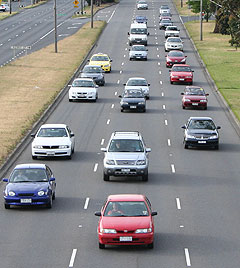Make / Model Search
News - General News - SafetyIndia tops global road tollIn a jam: India roads claim more than 105,000 lives a year. More people die on Indian roads each week than in Australia's annual road toll24 Jun 2009 THE World Health Organisation (WHO) has forecast that road accidents could increase from the ninth to the fifth leading cause of death globally by 2030, when 2.4 million could be killed annually on roads worldwide. Billed as the first worldwide road safety assessment, the World Health Organisation’s Global Status Report on Road Safety (GSRRS) has also found that almost half (46 per cent) of the estimated 1.27 million people who die in traffic crashes every year are not vehicle occupants at all, but pedestrians, motorcyclists and cyclists. The report found that more people die on Indian roads each week than on Australian roads annually. While last year’s Australian road toll was the lowest since 1949 at 1463, the report found that in 2006 some 105,725 people dies on roads in India, which averages out to more than 2000 every week. Based on 2006 figures, China had the second most deadly roads with 89,455 people killed, followed by the US (42,642), Brazil (35,155), Russia (33,308), Iran (22,918), Mexico (17,003), Indonesia (16,548), South Africa (14,920), Vietnam (12,800) and Egypt (12,295). The WHO says the GSRRS, funded by Bloomberg Philanthropies and released in Geneva on June 15, aims to gauge the implementation by individual nations of effective road safety measures, including limiting speed and reducing drink-driving, and increasing the use of seatbelts, child restraints and motorcycle helmets. The report presents information from 178 countries, which the WHO says accounts for more than 98 per cent of the world’s population. It said road crashes also cause between 20 million and 50 million non-fatal injuries every year, representing a significant cause of disability.  “We found that in many countries, the laws necessary to protect people are either not in place or are not comprehensive. And even when there is adequate legislation, most countries report that their enforcement is low,” said WHO director-general Dr Margaret Chan. “We are not giving sufficient attention to the needs of pedestrians, cyclists and motorcyclists, many of whom end up in clinics and hospitals. We must do better if we are to halt or reverse the rise in road traffic injuries, disability and deaths,” she said. The WHO study found the highest death rates were recorded in the Eastern Mediterranean and African regions, while the lowest rates are among high-income countries, such as the Netherlands, Sweden and the United Kingdom. Other key findings included: • Fewer than a third of countries meet basic criteria for reducing speed in urban areas. • Fewer than half of countries use the recommended blood alcohol concentration limit of 0.05 grams per decilitre as a measure to reduce drink-driving. • Helmet laws exist in more than 90 per cent of countries, but only 40 per cent have a law that covers both riders and passengers while also requiring that helmets meet a specified standard. • Only 57 per cent of countries have laws that require all car occupants to wear seatbelts, falling to 38 per cent in low-income countries. • Half of all countries do not have laws requiring the use of child restraints, ranging from 90 per cent of high-income countries to just 20 per cent of low-income countries. • Only nine per cent countries rate their enforcement of speed limits as over seven on a scale of 0 to 10, while the corresponding figure for enforcement of seatbelt laws is 19 per cent. • Traffic crashes are a leading cause of death, particularly among young people five to 44 years of age • More than 90 per cent of the world’s road deaths happen in low-income and middle-income countries, yet these countries account for 48 per cent of the world’s vehicles. “Our roads are particularly unsafe for pedestrians, cyclists and motorcyclists who, without the protective shell of a car around them, are more vulnerable,” said the WHO’s Department of Violence and Injury Prevention and Disability director Dr Etienne Krug. “These road users need to be given increased attention. Measures such as building sidewalks, raised crossings and separate lanes for two-wheelers reducing drink-driving and excessive speed increasing the use of helmets and improving trauma care are some of the interventions that could save hundreds of thousands of lives every year,” said Dr Krug. |
Click to shareGeneral News articlesResearch General News Motor industry news |









Facebook Twitter Instagram